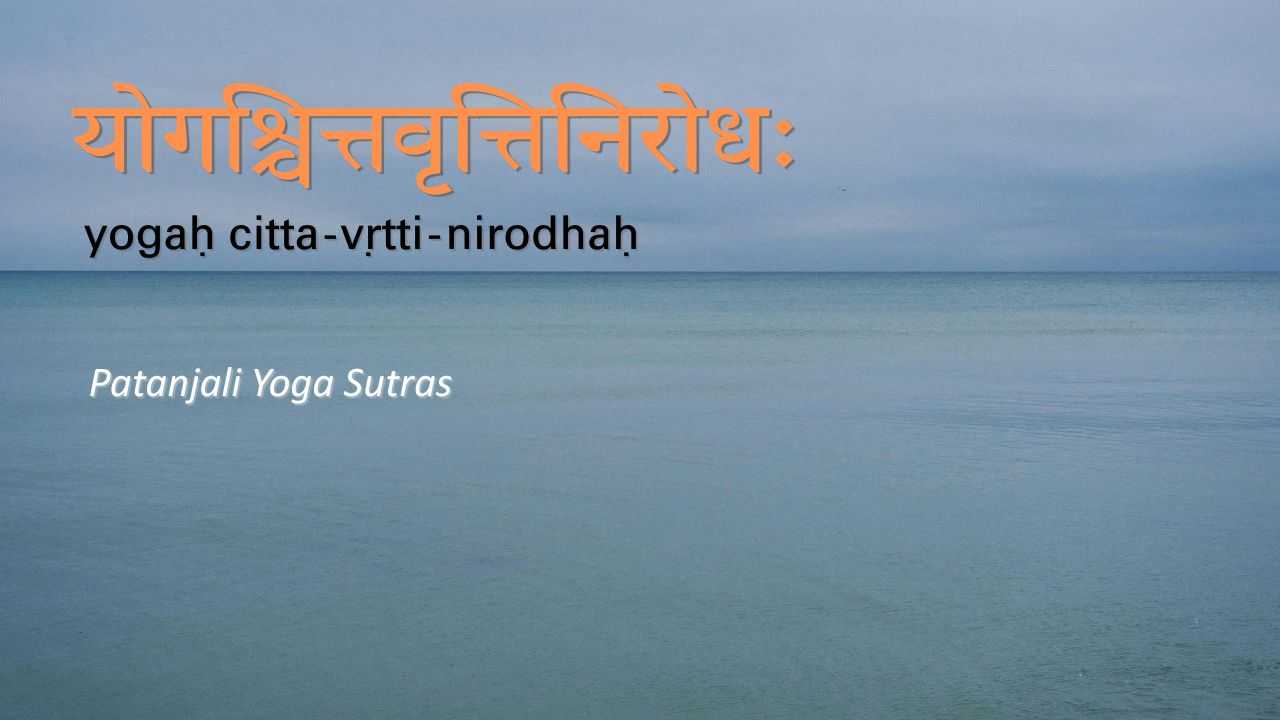
Patanjali’s Yoga Sutras are a cornerstone of yogic philosophy, offering profound insights into the workings of the mind and the true purpose of yoga. The celebrated second sutra encapsulates the very essence of yoga: yogaḥ citta-vṛtti-nirodhaḥ. In this article, revered Gurudev Anandmurti Gurumaa offers an insightful exposition on this timeless aphorism, revealing its intended meaning.
The Sutra:
योगश्चित्तवृत्तिनिरोधः
yogaḥ chitta-vṛtti-nirodhaḥ
yogaḥ: yoga is
chitta: subconscious and unconscious mind
vṛtti: movement, modification, turning
nirodhaḥ: cessation, stilling
“Cessation of all chitta vrttis is yoga.”
Precision of Sanskrit Vocabulary
Finding equivalent English words for Sanskrit terms is difficult because the Sanskrit glossary is so vast. For a single concept, there can be more than thirty words, each carrying a distinct nuance. To translate the Sanskrit aphorisms of Patanjali into English without compromising the spirit of the Sanskrit language is indeed tricky.
Meaning of Chitta and Vrtti
The word chitta encompasses the unconscious, the subconscious, and the conscious mind. Then comes the word vrtti. It doesn’t simply mean “thought”; that’s a mistaken translation. The word comes from vrt, which means “circle” – like a cup that holds something. The contents of that circle form what we call a thought.
Imagine a vast ocean. In this ocean, a wave arises. The wave is part of the ocean, yet it has a distinct shape and form. It may be called a small or big wave, turbulent, calm or just a ripple. Each wave has a defined form, and the amount of water it contains defines it as a wave. The ocean water takes the form of a wave, which soon collapses and loses its form, settling back into the ocean. The wave’s form is the “circle”. So, a wave is not the ocean, and yet it is the ocean. It rises and falls within the water. It takes a shape, and then it dissolves back.
Now, let’s apply this analogy. See your mind as an ocean. Within that ocean, a circle (vrt) shapes up, creating a wave. The content within that circle is called a thought. That thought may be a memory, sense perception, a projection into the future, or an imagination. Whatever appears in this circle is called vrtti – it’s a fine and subtle concept. The chitta is the ocean in which a circle, vrt, arises – with its content, it becomes a vrtti.
It’s like a painter drawing a circle and filling it with a mountain, river, man or woman, tree, grass, or field. Perhaps you’ve seen a painter creating a sketch, using different colours on a blank canvas. Within ten minutes, with a few strokes of colours, they paint a full scene – a mountain valley, or an ocean at sunset. Whatever gets created within that frame is the painting.
Similarly, the mind is never an empty canvas. Millions of pictures get created in the mind. All these impressions, gathered via the five senses, get layered in the mind. From this vast ocean of impressions arise vrttis. When a vrtti arises in that ocean (chitta), its content is loosely referred to as a thought.
Nirodha – Complete Cessation of Thought
Let’s now understand the term nirodha. People often mistranslate it as "destruction". That’s not correct. Nirodha can be understood as "to take hold of" or "to restrain". This restraint isn’t permanent; it occurs only for a brief, specific period.
Just think how many thoughts must have arisen in your mind since this morning – consider everything you have experienced through the five senses. The skin is the largest organ, so sensations like cold or hot enter the mind via the skin. Then there are the sights and colours seen through the eyes.
The mind often comments, like subtitling what you see. You say, “I see red, white, yellow, white or darkness”. Where do all these words come from? From memory. As your eyes see, your subconscious mind supplies the words: “This colour is this; that colour is that.” There’s no definitive barrier between the conscious and the subconscious – they function as a unified whole. It enables you to recognise what your eyes see.
So, if I were to ask how many vrttis occur in a day, or even in an hour, it would be impossible to count.
Now, what is yoga according to Rishi Patanjali? “Chitta-vṛtti-nirodhaḥ” – it is the state in which the vrttis are restrained. Remember, the vrttis of the chitta can’t be restrained forever, although many have this misconception. It may occur momentarily, after which one returns to the state of chitta, which may be klishta (pain-giving) or aklishta (beneficial and sattvic).
Patanjali says the objective of yoga is to hold or restrain (niruddha) the waves arising in the ocean of chitta. Note: he doesn’t speak of restraining thoughts of the mind, because the word used is chitta. And chitta includes the subconscious, unconscious, and conscious, woven together.
Mind ≠ Brain
I understand that, in the West, it is difficult to accept that the mind and the brain are two distinct entities. They say the brain is the mind. But this is not true. Hypothetically, if medical science someday manages to transplant a brain, will the knowledge of the donor transfer to the recipient?
The brain is a physical organ that functions on oxygen and glandular chemicals. It has specific areas for processes such as sight, hearing, touch, and movement.
Patanjali is neither referring to the brain nor the conscious mind alone. Chitta is all three: conscious, subconscious, and unconscious.
As we live through this body and mind, all three – chitta, brain, and body – function in sync and interact with the world. Patanjali speaks of creating a state in this chitta where, for a certain period, all vrttis are restrained – no vrtti is arising at all in the chitta. That means no sensory input is triggering a reaction in the chitta; no memory, no projection of the future, and no response to the body or surroundings.
A Treasured Text for Yoga Sadhakas
If you go deep into this very first aphorism of the Patanjali Yoga Sutras, it is truly mind-boggling. What is Raja Yoga? It’s about the restraint or halting of the vrttis of the chitta. How can we bring about this state? The ensuing sutras elaborate further.
Sage Patanjali emphasises that one must learn to bring restraint to the vrttis of the chitta. The first chapter, Samadhi Pada, is dedicated to the tools and stages one experiences when this niruddha state occurs. He discusses the types of samadhi, including savikalpa, nirvikalpa, sabeej, nirbeej, shabdanugat, and anandanugat.
In the second chapter, Sadhana Pada, he talks about what to do. In the third chapter, Vibhuti Pada, he describes the glorious achievements and the joy that accompanies them. The fourth and final chapter, Kaivalya Pada, describes the beauty of the states one attains through this long journey of preparation and yogic lifestyle.
There is such rich detailing in Patanjali’s work, and the subject isn’t simple. For those who wish to understand the mind, the unconscious, and the subconscious – and how to transform the state and experiences of the chitta, nothing compares to the Patanjali Yoga Sutras. I believe everyone should learn and work on comprehending the Yoga Sutras, one of the greatest scriptures of yoga.
Note: For more articles on yoga and Yoga Sutras, explore the following posts.
- Part 1 of this series: “What is Yoga?”
- Part 2 explored the first two limbs of Patanjali’s eight-fold path: “Yama and Niyama in Ashtanga Yoga: The Foundations of Spiritual Sadhana”
- Continuing from there, Part 3 provides an overview of the remaining limbs of yoga that take an aspirant to the goal of samadhi: “From Asana to Samadhi: Towards the Highest State of Yoga”
The Master’s comprehensive commentary on Patanjali’s Yoga Sutras is available as a video series, in book form, and digitally through the Amrit Varsha App.







